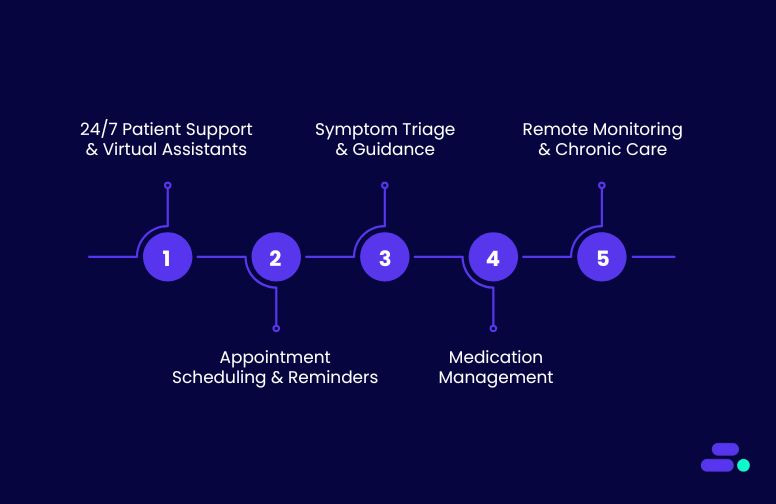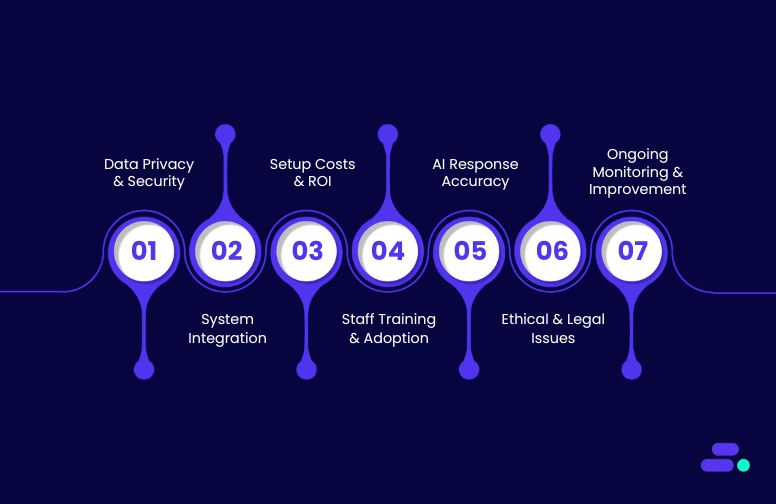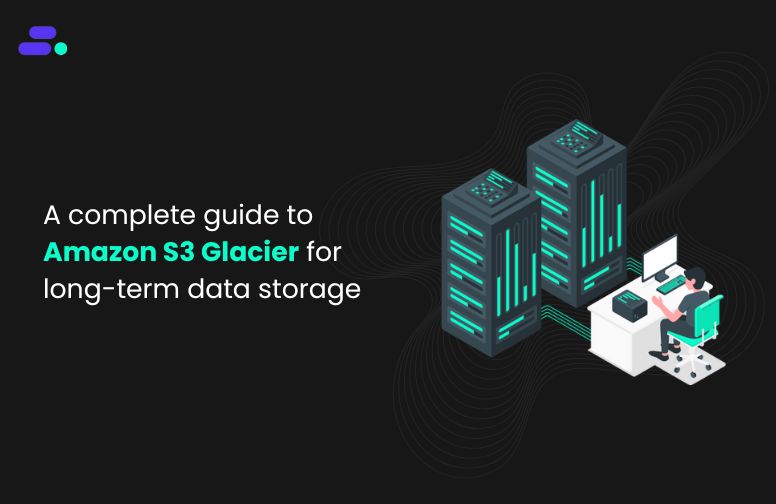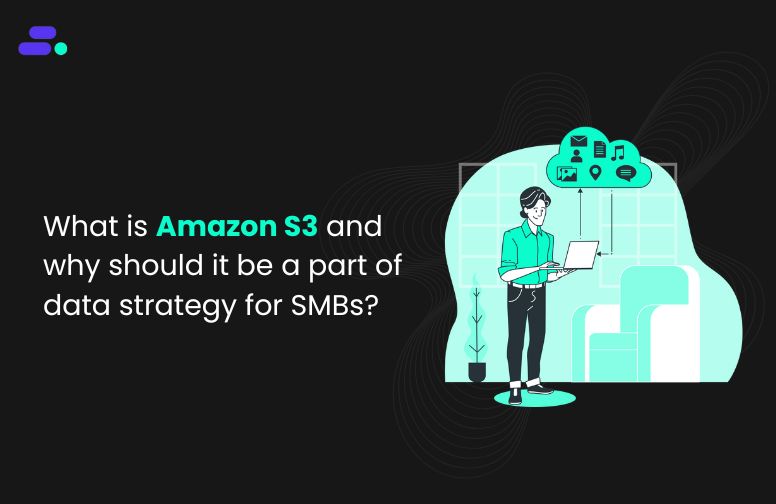This is a div block with a Webflow interaction that will be triggered when the heading is in the view.

Modernize your cloud. Maximize business impact.
For many small and medium-sized businesses (SMBs), moving to the cloud is no longer a question of if; it’s a matter of when and how. The challenge isn’t just about adopting the cloud, but choosing the right AWS migration strategy that fits business goals, budgets, and timelines.
AWS offers multiple migration paths, each designed for different needs and levels of cloud readiness, whether it’s reducing on-premise maintenance costs, improving performance, or building a more scalable foundation for growth.
This blog will break down 10 proven AWS migration strategies that help SMBs move smarter and get the most out of their modernization projects.
Key takeaways:
- Strategic AWS migration helps SMBs cut costs, boost scalability, and modernize operations for long-term business growth.
- AWS tools like Control Tower, MGN, and Redshift streamline governance, migration, and data optimization for SMBs.
- Building automation, resilience, and compliance into AWS migration ensures minimal downtime and maximum ROI.
- Continuous modernization post-migration keeps cloud environments agile, secure, and ready for future innovation.
- Cloudtech enables SMBs to migrate, modernize, and scale efficiently with AWS-based, business-aligned cloud solutions.
Why is strategic AWS migration essential for SMBs?
A strategic AWS migration can be a significant business enabler for SMBs. It helps SMBs modernize infrastructure, enhance agility, and optimize costs without the overhead of traditional IT systems.
Rather than lifting and shifting everything at once, a well-planned migration aligns cloud adoption with business goals, ensuring minimal disruption and maximum ROI.
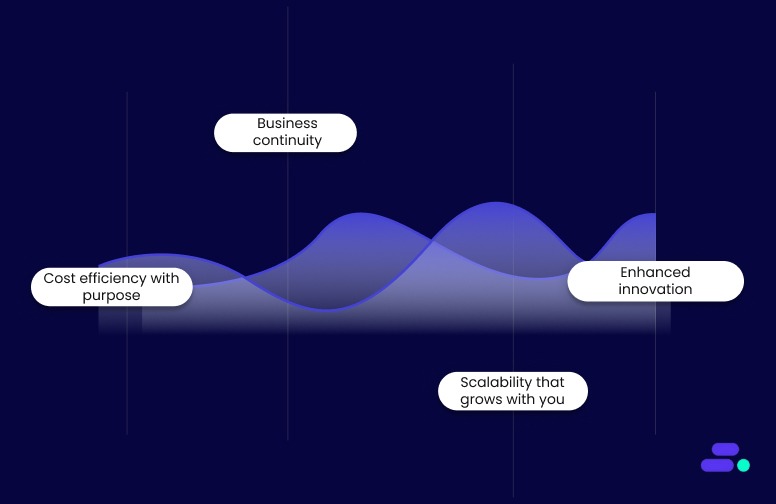
Here’s why a strategic approach matters:
- Cost efficiency with purpose: Instead of overprovisioning resources, AWS allows SMBs to pay only for what they use, reducing waste and improving financial predictability.
- Business continuity and resilience: AWS ensures uptime through built-in redundancy, automated backups, and multi-AZ (Availability Zone) deployments.
- Scalability that grows with you: SMBs can scale workloads instantly to meet demand spikes, whether during patient data surges, sales peaks, or seasonal fluctuations.
- Enhanced innovation and competitiveness: By freeing teams from infrastructure maintenance, businesses can focus on innovation, product development, and better customer experiences.
A strategic AWS migration helps SMBs build a secure, scalable foundation that supports growth, accelerates innovation, and keeps operations resilient, setting the stage for long-term success in a digital-first world.
Suggested Read: Best practices for AWS resiliency: Building reliable clouds

10 essential AWS migration strategies for growing businesses
Migrating to the AWS Cloud isn’t a one-size-fits-all process. Every business has unique workloads, dependencies, and goals, which means choosing the right AWS migration strategy is critical to success. For growing SMBs, applying these strategies with AWS tools ensures better scalability, security, and long-term cost optimization.
Below are 10 AWS migration strategies, each with a practical AWS implementation path and the resulting business impact:
1. Define a clear cloud migration roadmap
A migration roadmap ensures every decision supports business priorities. It clarifies dependencies, timelines, and success metrics, minimizing surprises during implementation.
For SMBs, this structured approach simplifies planning and keeps teams aligned on outcomes like faster deployment, improved uptime, and measurable ROI from every phase of the cloud journey.
How to implement:
- Use AWS Migration Hub to track and visualize migration progress.
- Apply the AWS Cloud Adoption Framework (CAF) for readiness assessment.
- Prioritize workloads based on business value and technical complexity.
Outcome: SMBs gain a focused, step-by-step strategy that reduces uncertainty, avoids costly rework, and accelerates time-to-value. A defined roadmap transforms migration from a technical project into a strategic business enabler that drives confidence and alignment across teams.
2. Assess and prioritize workloads
Migrating everything at once can overwhelm small IT teams. A thorough assessment helps determine which applications deliver the fastest benefits post-migration and which require modernization.
This ensures the most critical systems, like customer data platforms or billing, receive the focus needed for security, performance, and reliability from day one.
How to implement:
- Use AWS Application Discovery Service to map dependencies.
- Evaluate workloads on cost, performance, and compliance needs.
- Sequence migrations starting with low-risk, high-value applications.
Outcome: A prioritized migration minimizes complexity, reduces disruption, and accelerates adoption. SMBs can achieve early wins, gain stakeholder confidence, and progressively migrate more complex systems with a clear understanding of risks and benefits.
3. Strengthen cloud security and compliance from day one
Embedding security at every stage of migration ensures protection for sensitive workloads and customer data. For SMBs handling regulated information, like healthcare or financial data, this approach prevents breaches, ensures compliance, and reduces remediation costs. A security-first mindset creates lasting trust and operational resilience in the cloud.
How to implement:
- Manage access using AWS IAM and AWS Organizations.
- Enable encryption with AWS KMS and threat detection via GuardDuty.
- Continuously audit environments with AWS Config and Audit Manager.
Outcome: Security and compliance become continuous, automated processes, not one-time checks. SMBs maintain full visibility, meet regulatory requirements, and operate confidently knowing data, systems, and customer privacy are protected.
4. Automate migration workflows
Automation simplifies migration, reduces downtime, and removes human error. For SMBs with limited teams, automation ensures workloads are deployed consistently and tested thoroughly.
By integrating Infrastructure as Code (IaC) and CI/CD pipelines, organizations can scale operations faster and adapt to changing business needs with minimal disruption.
How to implement:
- Automate workload migration using AWS Application Migration Service (MGN).
- Deploy infrastructure via AWS CloudFormation or Terraform.
- Integrate testing and deployment through AWS CodePipeline.
Outcome: Automation delivers faster, error-free migrations and repeatable processes. SMBs achieve shorter timelines, consistent environments, and higher confidence in post-migration stability, freeing teams to focus on innovation instead of manual maintenance.
5. Optimize data migration and storage
Data is the lifeblood of modern businesses. Efficient, secure migration ensures minimal disruption and zero data loss. For SMBs, optimizing storage means balancing performance and cost, whether migrating transactional databases, analytics platforms, or file archives. This sets the stage for better insights and faster decision-making.
How to implement:
- Transfer large datasets using AWS DataSync or AWS Snowball.
- Migrate databases seamlessly with AWS Database Migration Service (DMS).
- Store and archive efficiently using Amazon S3 and S3 Glacier.
Outcome: A smooth data migration ensures high data integrity, minimal downtime, and predictable costs. SMBs gain flexible access to reliable, scalable storage that supports analytics, compliance, and future AI initiatives.
6. Enable observability and performance monitoring
Once workloads are live, visibility is critical. Proactive monitoring helps SMBs identify issues early, optimize performance, and ensure predictable user experiences. Continuous observability also strengthens compliance, enabling teams to maintain operational excellence with fewer resources and greater agility.
How to implement:
- Track system metrics using Amazon CloudWatch.
- Maintain audit trails with AWS CloudTrail.
- Use AWS X-Ray and Trusted Advisor for performance insights.
Outcome: Full visibility into cloud environments reduces downtime and improves responsiveness. SMBs can resolve issues faster, maintain compliance, and enhance end-user satisfaction with reliable and transparent cloud operations.
7. Build for resilience and disaster recovery
Disaster recovery isn’t just for large enterprises. For SMBs, even a short outage can lead to data loss or financial impact. Building resilience into AWS architecture through redundancy, automation, and failover planning ensures systems remain available even in the face of unexpected failures or disasters.
How to implement:
- Use multi-AZ deployments for fault tolerance.
- Implement backups using AWS Backup and Amazon RDS snapshots.
- Configure failover routing through Amazon Route 53.
Outcome: Business continuity becomes part of everyday operations. SMBs can recover faster, minimize downtime, and maintain customer trust by ensuring critical systems remain accessible and secure during disruptions.
8. Focus on cost management and optimization
Without governance, cloud costs can escalate quickly. Cost optimization strategies allow SMBs to scale efficiently while staying within budget. By monitoring usage, right-sizing resources, and automating cost controls, businesses can ensure they pay only for what delivers measurable value.
How to implement:
- Track spending with AWS Cost Explorer and Budgets.
- Use Savings Plans or Reserved Instances for steady workloads.
- Identify waste through AWS Trusted Advisor recommendations.
Outcome: Predictable, optimized costs free SMBs from financial surprises. Every dollar spent on AWS contributes directly to performance, innovation, and growth.
9. Upskill teams and foster a cloud-first culture
Technology adoption fails without skilled teams. Training staff ensures migration success and long-term cloud maturity. When teams understand AWS tools and best practices, they make faster, better decisions—turning the cloud into a strategic asset rather than a technical dependency.
How to implement:
- Offer training via AWS Skill Builder or Cloud Practitioner Essentials.
- Host AWS Immersion Days for practical learning.
- Build internal “cloud champions” for peer enablement.
Outcome: Empowered teams confidently manage and optimize cloud operations. This independence reduces reliance on external support and fosters innovation across departments.
10. Continuously optimize and modernize post-migration
Migration isn’t a finish line; it’s the beginning of continuous improvement. Post-migration optimization helps SMBs refine performance, reduce costs, and adapt architectures as business needs evolve. Modernization ensures that the cloud environment remains scalable, secure, and aligned with long-term strategic goals.
How to implement:
- Use the AWS Well-Architected Tool for regular architecture reviews.
- Modernize workloads using AWS Lambda, Amazon ECS, or Fargate.
- Enable AI and analytics through Amazon Q Business or Redshift.
Outcome: An optimized cloud environment delivers sustained value, including better performance, lower operational overhead, and readiness for future technologies. SMBs stay agile, competitive, and future-proof.
AWS migration success depends on strategy, not speed. By focusing on planning, automation, governance, and continuous optimization, SMBs can build a future-ready AWS environment that supports innovation, resilience, and measurable business growth, without overextending budgets or teams.
Also Read: AWS cost optimization strategies and best practices.

How does Cloudtech help SMBs implement AWS migration strategies?
For most SMBs, AWS migration is about building a secure, efficient, and future-ready foundation. Cloudtech simplifies this process through an AWS-based, SMB-first approach focused on modernization, resiliency, and measurable business outcomes.
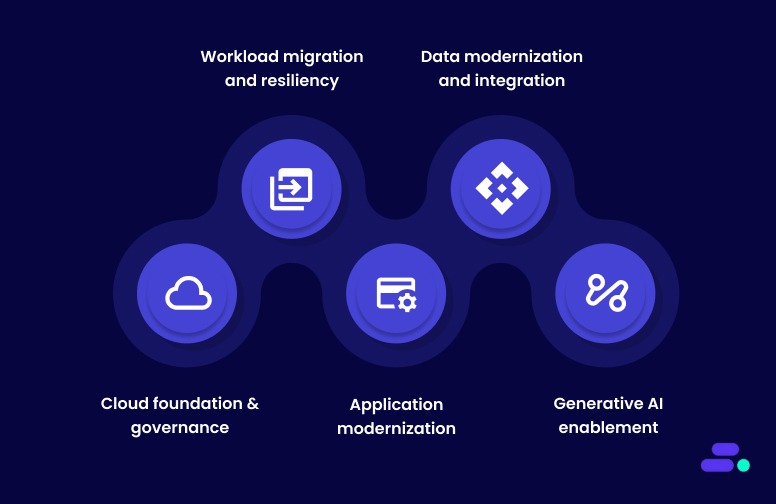
Here’s how Cloudtech enables successful AWS migration for growing businesses:
- Cloud foundation and governance: Cloudtech establishes secure AWS multi-account environments using AWS Control Tower, AWS Organizations, and AWS IAM. This ensures strong governance, identity management, and cost visibility from the start of the migration journey.
- Workload migration and resiliency: Using AWS Application Migration Service, AWS Backup, and Amazon Route 53, Cloudtech delivers structured migration plans with built-in disaster recovery, ensuring low disruption and high availability across critical workloads.
- Application modernization: Cloudtech modernizes legacy applications into scalable, serverless architectures using AWS Lambda, Amazon ECS, and Amazon EventBridge. This improves performance, reduces operational overhead, and enhances agility for faster innovation.
- Data modernization and integration: Through Amazon S3, AWS Glue, and Amazon Redshift, Cloudtech builds unified, cloud-native data foundations that support analytics, reporting, and intelligent automation across business functions.
- Generative AI enablement: Cloudtech helps SMBs unlock new capabilities using Amazon Q Business, Amazon Bedrock, and AWS data services, enabling practical AI solutions such as intelligent document processing and conversational analytics.
Cloudtech’s proven AWS migration methodology ensures SMBs don’t just move to the cloud; they modernize, optimize, and scale securely. The result is an AWS environment built for efficiency, compliance, and long-term business growth.
See how other SMBs have modernized, scaled, and thrived with Cloudtech’s support →
Also Read: Common security pitfalls during cloud migration, and how to avoid them

Conclusion
AWS cloud migration strategies offer businesses the flexibility to choose the right approach based on their unique needs, goals, and existing infrastructure. Whether opting for a quick "Lift and Shift" or a more involved "Re-architect" strategy, businesses can unlock enhanced scalability, security, and cost savings. The right migration strategy can set the foundation for future growth and efficiency.
For SMBs looking to fully utilize their cloud services, a partner like Cloudtech provides personalized AWS solutions, including infrastructure optimization, data management, and application modernization. Cloudtech’s expertise ensures businesses maximize the potential of their cloud environment, helping them scale and stay ahead in today’s competitive landscape.
Schedule a call with Cloudtech today to see how they can drive growth through secure, high-performing cloud solutions.
FAQs
1. What is the most common AWS cloud migration strategy for small businesses?
A: For small businesses, the "Rehost" (Lift and Shift) strategy is often the most common. It allows for quick migration to the cloud with minimal changes to existing applications, making it a cost-effective and straightforward option.
2. How do I know which AWS migration strategy is right for my business?
A: The right strategy depends on the business’s needs, current infrastructure, and long-term goals. If businesses need a quick move, "Rehost" may be ideal, while "Refactor" could be better to fully optimize for the cloud. Working with a cloud consultant can help determine the best fit.
3. How does the "Repurchase" strategy work?
A: "Repurchase" involves moving to a new, cloud-native application by switching to a software-as-a-service (SaaS) solution, rather than maintaining legacy systems. This strategy is ideal for businesses seeking modern, out-of-the-box cloud solutions with less complexity.
4. How can Cloudtech help my business with AWS cloud migration?
A: Cloudtech specializes in AWS infrastructure optimization, data management, and application modernization. Their tailored solutions can streamline operations, improve scalability, and ensure high security for industries like healthcare and fintech.
5. Can businesses retain certain applications on-premise while migrating others to the cloud?
A: Yes, the "Retain" (Revisit) strategy allows businesses to keep specific applications on-premise due to compliance, security, or other business-specific reasons, while migrating other workloads to the cloud for efficiency and growth.

Get started on your cloud modernization journey today!
Let Cloudtech build a modern AWS infrastructure that’s right for your business.

